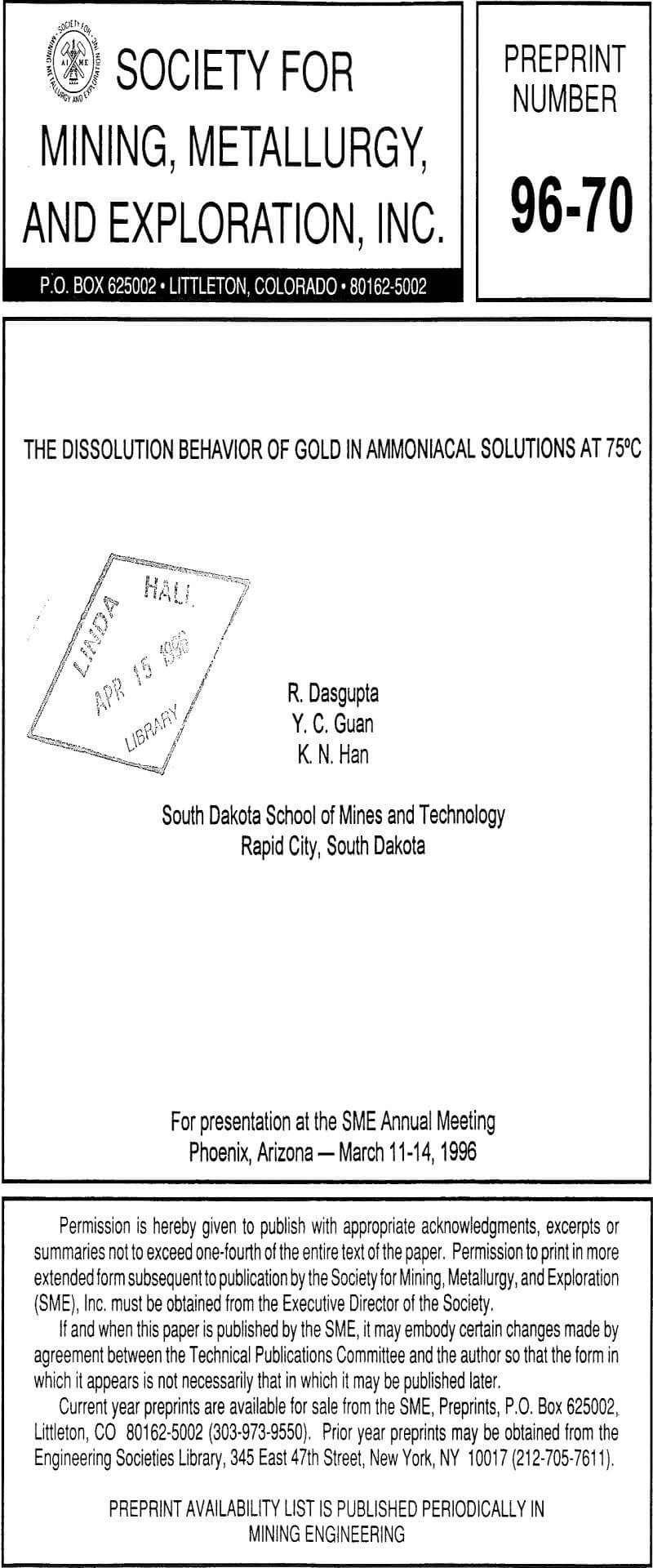Processes for gold extraction usually depend on how gold is associated with its environment. Although cyanide leaching remains the overwhelming option for the treatment of gold ores, because of its economy and simplicity, it suffers from certain inherent drawbacks such as toxicity, low leaching rate and its inefficiency of treating certain classes of refractory ores. Due to these limitations and increasingly stringent pollution control regulations, the use of lixiviants other than cyanide has received considerable attention in the past few years.
Ammonia has already been established as an effective complexing agent for transition metals such as copper, nickel, cobalt, silver, and platinum. It has a number of inherent advantages as a ligand due to its low cost, low toxicity, low corrosivity, easy regeneration due to its low vapor pressure and above all good complexing ability. It is possible to dissolve gold in ammonia solution at room temperature according to the thermodynamics of the Au-NH3-H2O system. But it has been reported in the literature that the kinetics of gold dissolution is very poor at low temperatures. Han and Meng (1993) carried out a detailed investigation on the dissolution kinetics of gold in ammoniacal media between 100°C and 200°C in an autoclave. The study revealed that the kinetics of gold dissolution in ammoniacal solutions under certain conditions of temperature, pressure and oxidants was favorable.
The dissolution of gold in aqueous solution is a redox reaction which takes place at the metal solution interface. In ammoniacal solutions, gold can be oxidized into Au(1) according to the following anodic reaction:
Au + 2NH3 = Au(NH3)2+ + e, E° = 0.572 V…………………………………………………(1)
If oxygen is used as an oxidant, the cathodic reaction can be written as (Antelman, 1982):
O2 + 2H2O + 4e = 4OH-, E° = 0.401 V………………………………………………….(2)
If another oxidant (other than oxygen) is used in the solution, the cathodic reaction represents the reduction of the respective oxidant. For example, if cupric ammine is used as the oxidant, then the cathodic reaction may be represented by (Antelman, 1982):
Cu(NH3)4+² + e = Cu(NH3)2+ + 2NH3, E° = 0.075 V…………………………………………..(3)
Although chemical techniques have been successfully used for the study, no attempts have been made so far on the electrochemical study of gold dissolution in ammoniacal media at elevated temperatures. Electrochemical techniques have an advantage because the reaction process can be separated into anodic and cathodic reactions. The study of these two reactions separately makes it possible to identify the mechanisms by which they occur and thus have a better understanding of the factors influencing the kinetics of the process.
The present study was aimed at carrying out the electrochemical study of the gold ammonia system with different oxidants. The principal objectives of the current investigation are summarized as follows:
- To study the electrochemical behavior of gold dissolution in ammoniacal media in the presence and absence of oxidants using potentiodynamic polarization techniques.
- To study the effects of operational variables such as temperature, pH and concentration of lixiviants on the dissolution characteristics of gold.
- To make a comparative study of different oxidants and their effectiveness in the gold ammonia system using mixed potential theory.
Experimental
Analytical grade chemicals were used throughout the study. Ammonia and Ammonium sulfate were used as lixiviants. The pH of the solution was adjusted by changing the ratio of ammonium ions (NH4+) to free ammonia (NH3). The pH of the solution was measured at room temperature and unless otherwise mentioned, this value was kept constant at 10.2. Sodium sulfate was used as the supporting electrolyte. The polarization tests were performed in an inert atmosphere by purging the solution with nitrogen for one hour before the start of the experiment and also during the experiment. Oxygen was used only during the tests in which the role of oxygen as an oxidant in the system was being investigated. Nitrogen and oxygen were obtained from the Air Products Company located at Rapid City, South Dakota. All of the tests were performed at 75°C using a constant temperature water bath with a thermometer to record and monitor the temperature.
The dissolution behavior of gold in ammoniacal solutions at 75°C has been studied by electrochemical techniques using a static disc electrode. The following conclusions can be drawn from the experimental results of this study.
- The anodic polarization study showed that the dissolution current increased with the increase of the overpotential before gold became oxidized at 0.46 V versus SCE in ammoniacal solutions. The current density peak during anodic polarization at 0.46 V versus SCE is believed to be due to the formation of Au(OH)3.
- Cupric ammine is a potential oxidant in the Au-NH3, H2O system. The reaction order with respect to Cu(NH)4²+ was found to be 0.38. Cupric ammine has no effect on the anodic reaction.
- The rate of dissolution of gold was not affected by the increase of the total ammonia ([NH3] + [NH4+]) concentration of the solution.
- Increase of temperature had a significant effect on the dissolution rate of gold. The Arrhenius activation energy was calculated to be 61 KJ/mole which suggests a chemical reaction controlling step in the dissolution process.
- The rate of dissolution increased with pH of the solution up to a value of about 9. Further increase of pH had no effect on the rate of dissolution.
- Different oxidants like Cu(NH3)4+², Co(NH3)6+³, O2, H2O2 and combination of Cu(NH3)4+² and O2 had no effect on the anodic reaction during the dissolution process of gold. It is believed that the positive influence of the oxidants on the leaching rate is due to the increase of the cathodic current density and the dissolution potential. Cu(NH)4+² and O2 have a synergistic effect on the dissolution rate. The oxidizing power of the various oxidants can be summarized as follows:
Cu+² > Co+³ > O2 > H2O2

